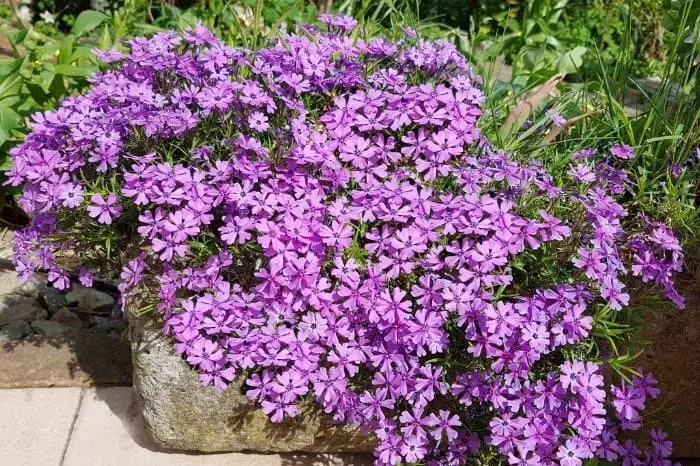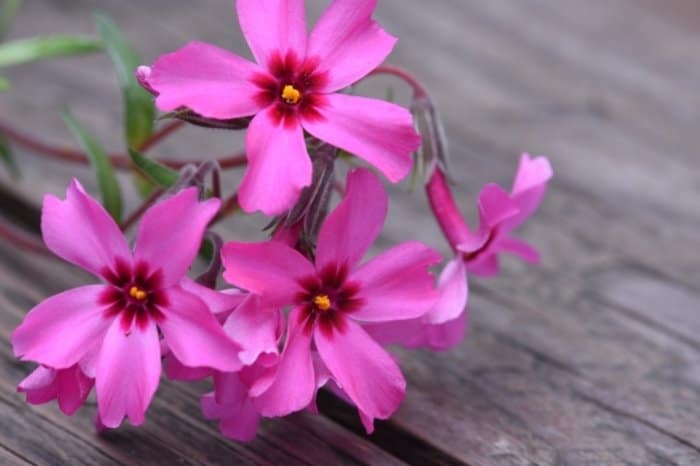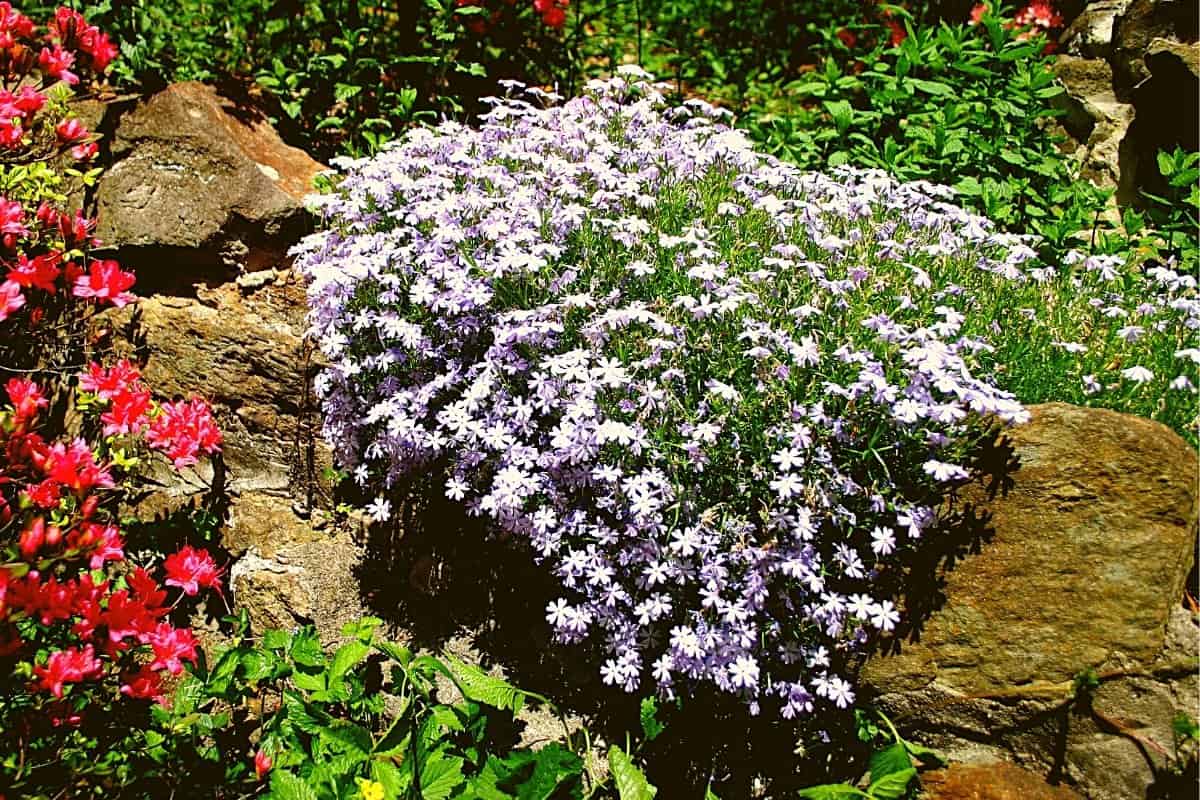Last Updated on December 29, 2022 by Sharon Vanessa
Once you know when to plant creeping phlox, you can go ahead and get it going but be sure to wait until the soil is warm enough before planting.
Creeping Phlox (Phlox subulata) is a common plant that produces a colorful spring carpet of soft pastel hues. They are easy-to-grow perennials that come back consistently every season. Little care and maintenance are needed for this plant.
Growing creeping phlox over a rockery or in tough soil provides a carefree ground cover or cascading plant.
Phlox Types
The creeping phlox comes in two forms – garden phlox (phlox paniculata) and creeping phlox (phlox subulata). These two types produce fragrant blooms that attract a variety of pollinators that include hummingbirds and butterflies.
- Garden Phlox – This is an upright fragrant flower that grows to about 3 feet tall. It blooms in the mid-summer producing large flower clusters that have a light pleasant fragrance. It blooms in mid-summer and makes a lovely addition to summer bouquets. It is a great addition to cottage garden landscapes, cutting gardens, and pollinator gardens.
- Creeping Phlox – This is a low-growing groundcover with foliage that forms an attractive mat-like structure after the bloom. This type blooms in spring and looks great when mixed with other spring-blooming bulbs like daffodils, and tulips. It also does well as edging plants or planted on slopes or stone walls where it can grow and spill over the edges.
Best Time To Plant Creeping Phlox
Creeping phlox can be planted in spring or fall and must be planted immediately after you receive them.
-
Planting In Spring: If your plant arrives in the spring, keep it moist in the container until your ground is ready for planting. Hold off on spring planting until the soil is free from melted snow and ice and the soil is warm and ready to work.
-
Planting In Fall: If you receive your plant in the fall, keep it for few days until it’s ready to plant. But you must watch out not to let the roots dry out. Be sure to plant a few weeks before your first frost arrives.
This plant requires that you plant it in the right atmosphere for it to thrive. If you don’t provide it with the right growing conditions, it will not do well.
Dr. Earth GL61100518430 Fertilizer & Soil 707P Organic 8 Bud & Bloom Fertilizer
What Are The Right Conditions For Creeping Phlox Planting?
-
Soil –Phlox is tolerant to most garden soils but it thrives in well-drained soils particularly in the Northern areas where spring is snow drains slowly. Waterlogged damp spring soil can’t rot dormant phlox roots. You may add peat moss or compost to the garden to improve drainage and create a better growing environment.
-
Light – Both varieties of phlox love to enjoy full sun, although the garden phlox can take a little shade in the afternoon.
-
Spacing – Your phlox must be spaced to give them the growing space they require to thrive. Garden phlox should be planted about 18 inches apart while creeping phlox should be planted about 2 feet apart.
Allowing these plants lots of room for circulation is the key to limiting mildew appearance. Mildew is less found as most varieties are able to resist it but do not plant them too closely.

Over the next few years, you will see the variety you plant from clumps that will gradually increase and join together to form one large grouping of phlox. The creeping phlox variety forms a carpet or a mat.
Growing Creeping Phlox Throughout The Season
Each spring, you will see the dormant crown of garden phlox start to emerge from its dormancy and produce small green leaves. Keep your plants weed-free and let the phlox just grow. Eventually, tall stalks will start to shoot skyward from the base of the plant.
Spring sunshine encourages the creeping phlox bloom. A few weeks of the sunshine and the creeping phlox will be covered in colorful blooms. The bloom continues until the weather turns to summer heat but you might find a few flowers come back during the cooler summer or fall.
Water your phlox regularly until they become established. Once established they don’t need much water. Seasons with regular rainfall do not require you to water your phlox. They are drought-tolerant but they struggle with water-logged soil.

Are All Phlox Creeping?///
NO
Creeping phlox (Phlox stolonifera) is a low-growing, mat-forming plant that is often seen spreading as a ground cover, in rock gardens, and even in crevices of stone walls.Creeping phlox adds a sweet vanilla-clove scent to the garden that attracts hummingbirds and butterflies. This low-growing ground cover reaches from 3 to 8 inches tall. Phlox subulata, also known as thrift phlox or garden phlox, is a hardy, low-growing evergreen plant with a mossy appearance.There are several different kinds of phlox. Garden and meadow phlox produce large panicles of fragrant flowers in a wide assortment of colors. They also add height, heft, and charm to a border. Low-growing wild Sweet William, moss pinks, and creeping phlox are effective as ground covers.
How Do You Stop Creeping Phlox From Spreading?
Creeping phlox is a common garden plant.
It’s best to plant it in a row, in a sunny location, where it can benefit from extra water during the hot summers.
Then, fertilize in late winter and early spring with a general slow-release fertilizer for flowering plants.
However, be careful to plant phlox at least 6 inches apart, and do not over-fertilize.Creeping phlox (Phlox subulata) is an invasive species, spreading as wide as 9 inches (20 – 60 centimeters). Although the phlox species make for a good ground cover, they can alter your landscape, prevent sunlight from reaching your other plants, and do a lot more.
Because it is an invasive plant, it can take over a space if allowed to grow unchecked. It can also take over your yard if it’s not cultivated, and choke out other plants, as a result.
The plants are a weed and must be removed immediately. If you want to keep it in a garden, deadheading is the only way to keep it from spreading out.
The first step in stopping creeping phlox from spreading is to control its growth and spread.
These plants spread by sending out long, leggy runners. To prevent this, plant them in staggered rows, leaving a few inches of space between each plant.
They can be planted directly into the ground, but if you want to prevent them from spreading, soak the root balls first and follow the directions on the package.
Unlike many other plants, creeping phlox doesn’t require a lot of water or fertilizer to grow, so you’ll need to weed it often.
Fortunately, it’s pest-resistant, so you’ll have less trouble with spider mites than with other types of weeds.
In addition to weeds, this species needs moderate amounts of moisture to stay healthy, so you can reduce your watering costs by irrigating during dry spells.
Is Creeping Phlox And Creeping Thyme The Same Thing?
No, creeping thyme and creeping phlox are not the same plants. Even though they look the same, they belong to two different plant families.
The “creeping phlox” common name is used for two plant species: Phlox stolonifera and Phlox subulata. One of the most important differences between creeping phlox and creeping thyme is their classification. The “creeping phlox” common name is used for two plant species: Phlox stolonifera and Phlox subulata.
Creeping thyme, aka thymus praecox, is a drought-tolerant, ground cover plant that’s a perfect addition to rock gardens, as it does not do well with the heavy foot traffic lawns typically receive. Grown in full sun, thyme is also used to flavor certain foods.USDA Hardiness Zones: 5 to 8
The perfect option when xeriscaping, this ground cover prospers in full sun and is resistant to drought, pollution, and poor soil conditions. Reaching a height of 4 to 6 inches, creeping phlox produces a carpet-like look.USDA Hardiness Zones: 3 to 10
How Long Does It Take To Grow Creeping Phlox From Seed?
Creeping phlox germinates quickly and you will likely have sprouts within a month or two, depending on the variety.Seeds should germinate in 5-10 days. Just cover the small seeds, and germinate at 16°-18°C (60°-65°F). Thin or space transplants at 20-30cm (8-12″) apart. This cool season plant may slow down in the heat of high summer.Phlox is very easy to grow and maintain, and once it’s established, it’s fairly drought-tolerant.The perennial phlox seedlings can be put into the garden when they are large enough to handle easily. They do grow slowly the first year and usually do not bloom until year 2. Annual phlox will bloom the first year and set seed which can be collected or, in mild areas, left to self-seed for next year.
//
FAQs
What month do you plant phlox?
If you have been thinking about planting phlox in your garden this year and wondering what the best month to plant them is that is April to be able to transplant them into the ground in June when the weather gets warmer. The reason for wanting to plant them in April is that they will be ready to bloom in August.
Phlox are great in pots but when planted in the ground you need to make sure they have a good base of organic matter such as peat or compost that can hold moisture and prevent dry rot. If you are not sure what type of soil you have on your property then you should contact a local garden center and ask them.
What's the best way to plant creeping phlox?
You want to use a "creeping" phlox, which means it spreads by underground rhizomes. These have an average spread of about 1' per year. The easiest way to get one is to buy one in a pot or container, and plant it in the garden. If you do this, be sure to leave a hole for the rhizomes to come out.
You can also put them in the ground, but they won't get as big. Phlox, like all plants, need to be watered regularly. Use a soaker hose, or a rain barrel if you have one.
They do well in cold temperatures, so don't worry about them freezing. I've found that if I give them too much water, they can grow too fast and get leggy.
How long does it take for creeping phlox to spread?
Creeping phlox is actually a small annual that creeps along the ground. It can reach up to three feet long. Creeping phlox grows in shady areas and is hardy to Zone 5. The flowers bloom in late spring and early summer.
Creeping phlox is a very slow growing plant. You can see photos of plants in the nursery and you can see that they are all still tiny plants. The first plants you see will be about 1-2 years old, but it is not uncommon for them to still be small plants at 3 years old.
Creeping phlox is a favorite for container gardens. It looks great in hanging baskets, window boxes and on deck railings. It can also be grown in hanging baskets or window boxes in ground beds. Creeping phlox loves shade and so does the plant. It prefers to grow in well drained soil.
Does creeping phlox stay green in winter?
It's an evergreen shrub, and I've been able to keep it watered and fertilized throughout the winter.
Every garden needs a dash of color in spring and the easiest way to get yours is by planting creeping phlox. Taking care of this perennial is easy that’s why most people grow it.
Creeping phlox spreads fast and has small star-shaped flowers. These flowers can be white, red, blue, pink, purple and cover an area of 24 inches in width.
This fabulous little plant blooms in mid or late spring and once the summer rolls in, you will get to enjoy its green foliage that looks equally good.
Finally, creeping phlox is perfect for landscaping or rock gardens and above all not toxic to pets!
Caroline is a gardener who loves to get down to the nitty–gritty of gardening. She proudly proclaims herself as a ‘dirt worshipper‘ and can often be found deep in the garden, covered in soil and singing to her plants. As a self–proclaimed ‘plant whisperer‘, Caroline believes that plants need love and attention just like any other living thing, and she loves to give them both. When she‘s not tending to her garden, you can often find her researching the latest gardening trends, or teaching others how to make their gardens thrive



